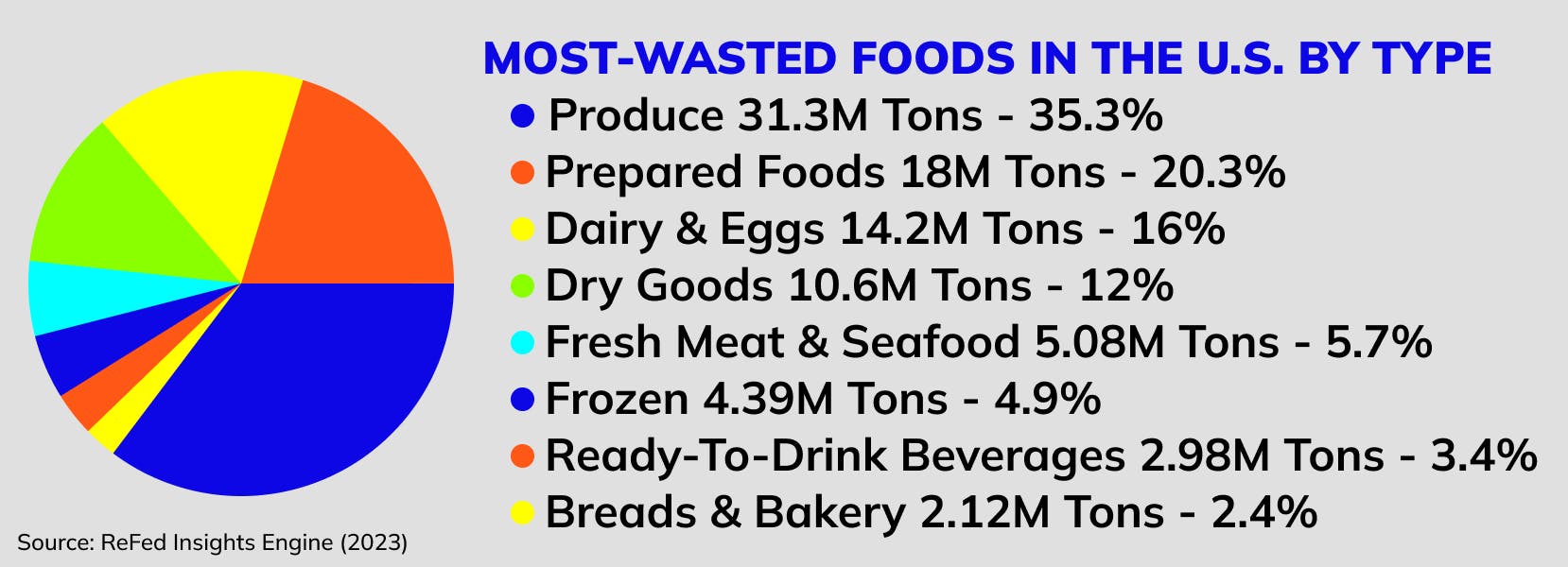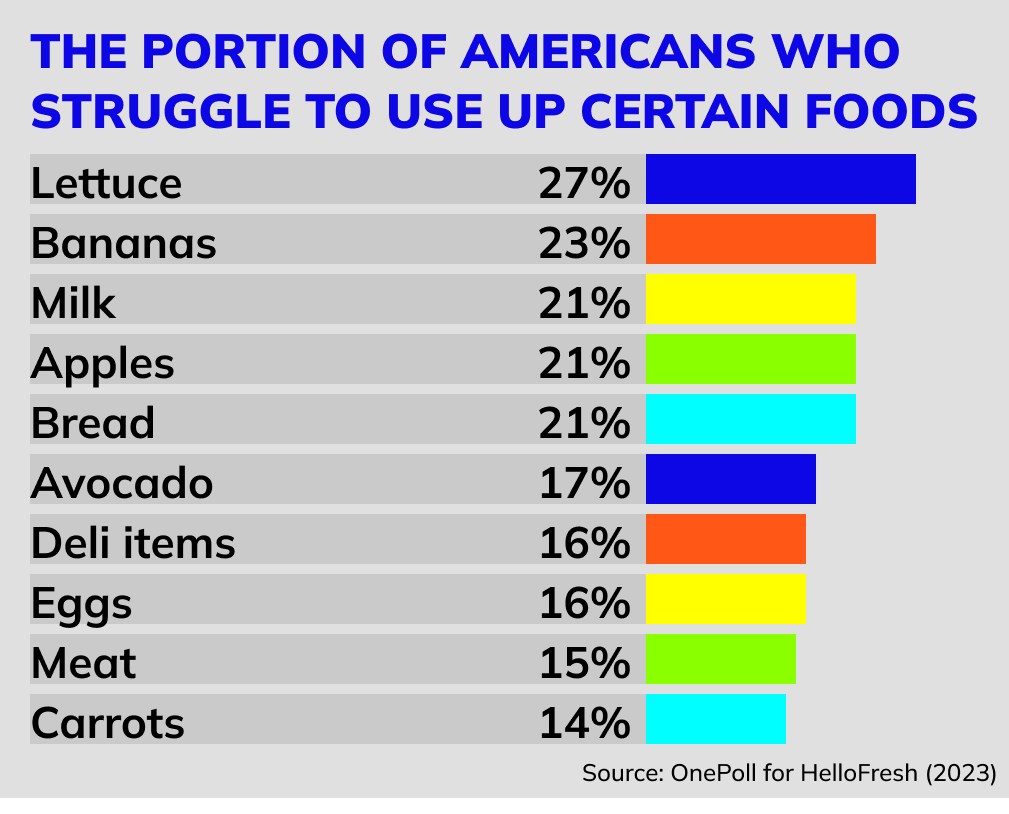After holidays, big celebrations, or even just a dinner party, refrigerators and pantries tend to be stuffed with delicious, if immoderately portioned, leftovers. Food waste in U.S. households is so rampant that an entire category of food writing reemerges every November to tell us what to do with too much turkey before it spoils. But long after the festivities have died down, it’s not hard to find wilting greens, molding grapes, or other food wasting away in the average American refrigerator.
While food waste may be a normal problem to have in the U.S., it’s not a harmless habit.
How much food is wasted in U.S. households?
The short answer: a whole lot of food. Federally funded research published in 2020 found that the average household wastes 31.9% of their grocery cart, equal to around $240 billion in essentially unnecessary expenses.1 Globally, households wasted over one billion meals a day in 2022. 2
What are the most commonly wasted foods in U.S. households?
Food waste in American households spans categories, but analysis from ReFED, a nonprofit focused on food waste solutions has spotted some trends across all sectors—from homes and restaurants to grocery stores and farms.3 Produce tops the list by a wide margin, making up double the wasted grub of the next-closest category: prepared foods.

As for what specific foods U.S. homes toss most often, common perishables come out on top. In April 2023, meal kit company HelloFresh released the results of a commissioned survey on U.S. food purchasing and waste habits. Their poll of 2,000 Americans showed some patterns, but nonetheless highlighted that there isn’t a single type of product that is overwhelmingly wasted more than others.
To the surprise of no one, wasted lettuce and bananas were top of mind for respondents, who noted they were the hardest ingredients or food items to use up. But milk, apples, and bread weren’t far behind, nor were avocados, a notoriously fickle fruit to store until use.
Here’s the full, ordered list of what HelloFresh poll respondents said were their toughest foods to eat before spoilage.

What are the main causes of food waste in U.S. households?
The majority of Americans—77% according to one survey—say they feel guilty when they waste food.4 So why aren’t we better about the amount of food that ends up in the trash?
The Conservation Law Foundation (CLF) says there are six main causes of food waste in U.S. households labels are confusing; food is available in oversized servings and containers; consumers want perfect-looking produce; food waste isn’t widely tracked; stores are overstocked with perishable items; and a lack of food rescue and recycling services.
These explanations are all interrelated. The problem starts at the grocery store. Grocers stock more food than customers will typically buy. Meanwhile, choosy choppers want to head home with only the prettiest produce they can purchase. Once they get their grub home, it’s hard to decipher the dates on food labels: ‘Expires on,’ ‘best by,’ ‘sell by’ dates and similar food packaging notes aren’t actually regulated to a standard for safe consumption. “In the United States, manufacturers provide dating to help consumers and retailers decide when food is of the best quality,” explains the National Sanitation Foundation. “Except for infant formula, dates are not an indicator of the product’s safety and are not required by federal law.”
Another problem is that food is sold in portions bigger than people can handle, whether that’s prepared foods and restaurant meals or prepackaged produce and proteins. “Many food retailers serve such large portions that you can’t eat a meal all in one sitting,” notes the CLF. “And too often, the leftovers go uneaten at home, too.”
What are the environmental effects of household food waste?
Once wasted food or scraps are chucked in the garbage, they begin to decompose and generate methane, a greenhouse gas that’s around 28 times more potent than carbon dioxide.
In fact, the amount of wasted food sent to our landfills creates enough methane to rival the amount of carbon dioxide emissions spewed by 42 coal-fired power plants.5 To that end, local government officials from around the country recently implored federal environmental officials to help reduce emissions and end the landfilling of food waste and scraps by 2040.
Food scraps also contribute to the nation’s landfill capacity problem. The U.S. is quickly running out of space to throw out its trash, and the massive amount of food being dumped every minute aren’t helping. According to the National Renewable Energy Laboratory, many landfills are running close to capacity and a significant number are scheduled to close by 2050.
Are there laws or policies aimed at reducing household food waste?
In the U.S., there are no federal laws regulating what date labels on food products need to have. And according to Insight Engine, a legislation tracking database, only New Jersey and North Carolina have considered legislation mentioning expiration date labels in recent years. Legislators in New Jersey did pass a bill in 2019 “urging food manufacturers to drop “best by” labels for the sake of reducing food waste, but there was no apparent compliance lever.
Other laws regarding food waste have passed at the state and federal level to broadly address other issues that drive food waste, like limiting liability around donated food, a measure that helps potential donors feel confident that they can’t be sued over less-than-perfect food donations.
However, the most visible policy changes for households would probably be around food scrap collection programs. More and more state and local officials are forming such programs, which take food that would otherwise be wasted and turn it into compost or biogas. Washington, D.C., for example, operates both food scrap drop-off locations at farmers markets throughout the city and a curbside food scrap collection pilot program at single-family homes. Some cities, like San Francisco and Seattle, have required composting for over a decade.
If you’re interested in learning about your specific state’s policies, ReFED, a food waste solutions-focused nonprofit, has an online portal where you can read up on the latest bills and laws targeting food waste.
Simple tips to reduce food waste at home
Getting out of the habit of wasting food does require a mindset and activity shift. But that transition doesn’t have to be unpleasant. No matter what strategies you put in place, remember to give yourself grace. Not every sandwich can be saved. Even the most ardent food waste avoiders are prone to occasional forgetfulness that begets food waste. But dwelling on embarrassment—and losing sight of the overall progress you’ve made—might make you lose momentum.
Shopping tips to avoid food waste
Going on vacation soon? Have an out-of-town foodie friend visiting who’ll want to experience new restaurants? You’re not going to be eating at home, so don’t shop like you will. Anticipate leftovers coming into the house and instead look at your existing condiments and meal prep accoutrement that can jazz up the last few bites. Explore more shopping tips to reduce food waste.
Cooking tips to reduce food waste
There’s lots of delicious things to be made with the stuff you’re inclined to trash. Take butternut squash, for example. Most recipes would call for deseeding it before further preparation. But those seeds are delicious in their own right after they’re cleaned of the squash gook, drizzled in olive oil, and lightly spiced and roasted. Check out more cooking tips to avoid food waste.
Storage tips tip reduce food waste
Is it a pain to memorize what produce should be stuck in the fridge, left on the counter, or even tucked into a paper bag? Definitely, but keeping an organization chart handy until those best practices become second nature will save you a lot of money and frustration by extending the shelf life of your food. And don’t forget to utilize your freezer. You’ll thank yourself for storing produce and fresh products in the chiller when they’re at their best to use during less-bountiful times, like midsummer tomato sauce in December. Explore more storage tips to reduce food waste.
What at-home technologies help reduce household food waste?
Numerous apps and smart tech tools exist to encourage households to eliminate food waste. For instance, Samsung sells refrigerators that can tell you what’s in your fridge from your phone, so, for example, you can fact check your brain when you aren’t sure if you finished the grapes or not.
Don’t have money for a fancy fridge? Different phone apps can help nudge you in the right direction. At least one, called Olio, helps connect you with like-minded neighbors to redistribute food you don’t have time or interest to eat. Numerous websites and apps, like SuperCook, will tell you what recipes will use up your leftover ingredients if you tell it what you have. But these tools aren’t silver bullets; they work best if you’re dedicated to a multi-pronged approach to waste reduction.
What is the scale of food waste globally compared to the U.S.?
The amount of food waste generated across the globe isn’t well known, because there’s not a lot of available data. However, according to the United Nations Environment Programme (UNEP), what we do know is that the U.S. isn’t alone in being a glutton for food waste.
While key data gaps exist at the household level in lower-income countries, small island states, central Asia, and north Africa, 14 countries have strong household food waste estimates.6 Most of those are European nations, like Austria and Denmark, but include Australia, Ghana, Saudi Arabia, and the U.S. The data we do have for other countries still paints a grim picture of a global food waste trend, seemingly regardless of income level.
The UNEP’s report finds that on a per-capita annual basis, households in high-income and upper middle-income nations respectively waste an average of 79 and 76 kilograms, or 174 and 167 pounds, per person. Lower-middle income nations’ households, in contrast, waste an average of 91 kilograms, or 200 pounds, per year, which UNEP considers to be a “broadly similar” amount of food waste.
- Estimating Food Waste as Household Production Inefficiency, American Journal of Agricultural Economics, Mar. 2020 ↩︎
- UNEP Food Waste Index Report 2024, United Nations Environment Programme, Mar. 2024. ↩︎
- ReFED Insights Engine, Nov. 2023 ↩︎
- Household Food Waste: Multivariate Regression and Principal Components Analyses of Awareness and Attitudes among U.S. Consumers, PLOS One, Ju. 2016 ↩︎
- From Farm to Kitchen: The Environmental Impacts of U.S. Food Waste, U.S. Environmental Protection Agency, Office of Research and Development, Nov. 2021 ↩︎
- UNEP Food Waste Index Report 2021, UN Environment Programme, Mar. 2021 ↩︎

